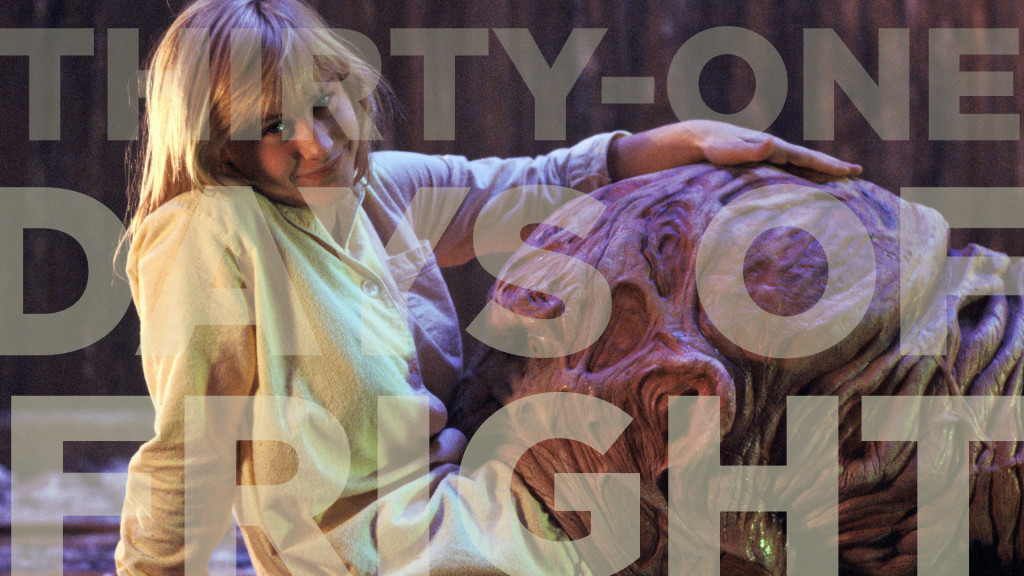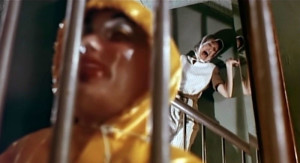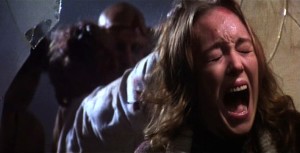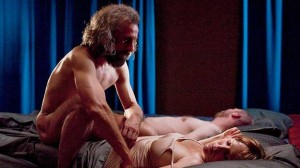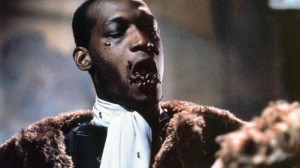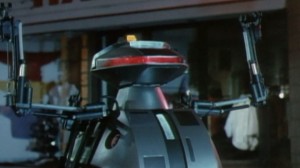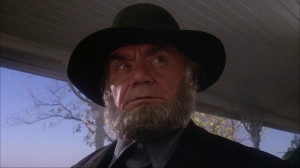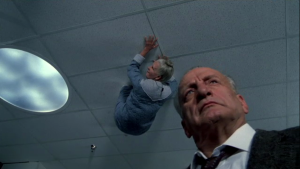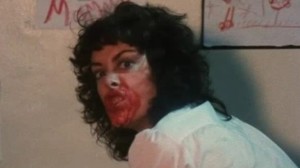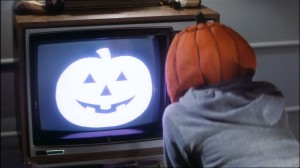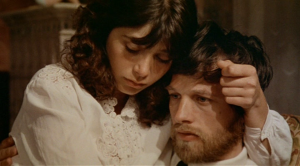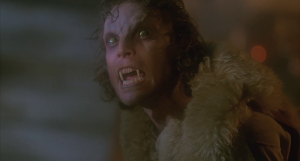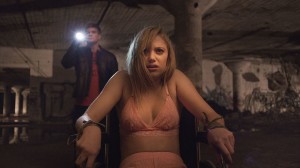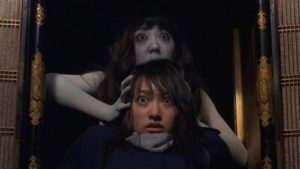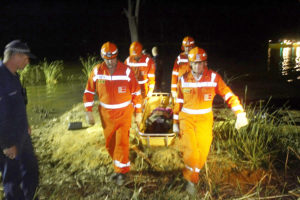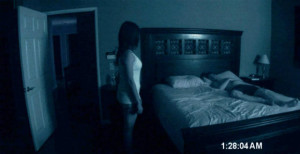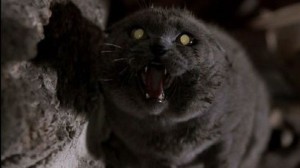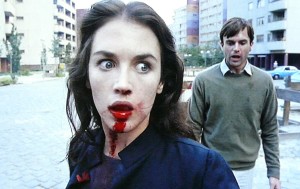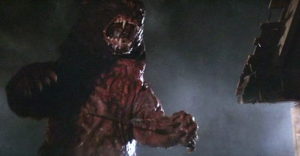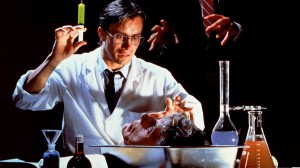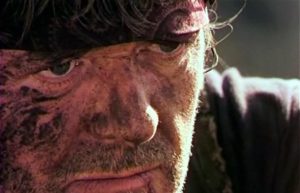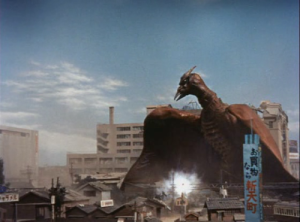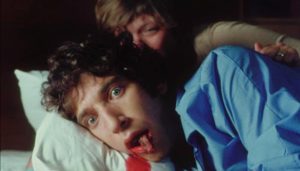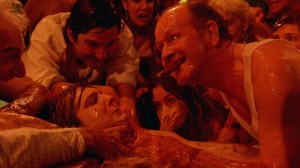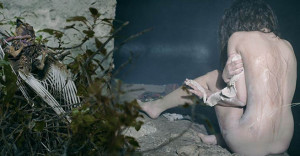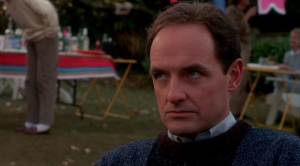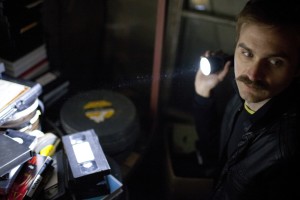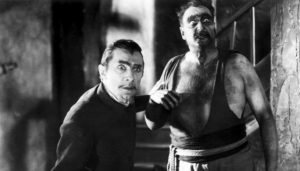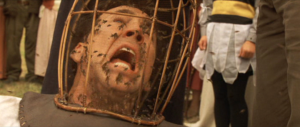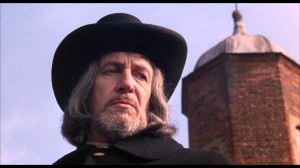
This hotel is not going to get a good Yelp review.
This January, in support of the Toronto Rape Crisis Centre / Multicultural Women Against Rape, friends and family have raised over $1,000, which means I have to watch and write about thirty-one horror movies. I’ll watch (on average) one movie a night, many of them requested by donors, after which I’ll write some things about said movies on this website. Be forewarned that all such write-ups will contain spoilers! The final film of 31 Days of Fright is The Beyond (don’t watch the trailer if you’re squeamish!), the notorious Italian gorefest directed by Lucio Fulci (City of the Living Dead, Zombi 2). The final film of my month-long endeavour was selected by donor (and my very wonderful girlfriend) Meg Campbell. It should be noted, however, that Meg has never seen The Beyond, and suggested it on the basis of it being the favourite movie of a former horror-buff co-worker of hers. The Beyond was rented, like most of the films this month, from the kind folks at Queen Video.
What happens:
The final horror movie I watched in January opens, like most great horror movies, in sepia tones. The setting is 1927 Louisiana, where a number of men row their boats through the Louisiana swamps, wielding torches. Inside a stately hotel, a young blonde woman lights a candelabra and opens a book emblazoned with the title, “Eibon.” Upstairs in the hotel, a man manically paints a canvas. The boatmen join a carful of other men once they hit land, and the angry mob enters the hotel, wielding guns and chains. The woman notes that she has collected all the prophecies of Eibon over thousands of years in the book. Meanwhile, the angry mob bursts into Room 36, where they surprise the intense painter, positively twitching in his artistic endeavours. The mob leader labels the painter an ungodly warlock and beats him across the face with a chain.
The woman with the book notes that there are seven gateways to Hell, kept in seven secret spaces. Funnily enough, the painter (while being savagely beaten with chains), says basically the same thing, but adds that the hotel they’re inside is one of those seven doorways. And only he can save them all from what lies on the other side. The men don’t like hearing that, so they beat him some more, then follow that up by nailing him to the wall with iron spikes, crucifixion-style, and covering him with scalding oil. He continues to scream as the oil melts his face for an inordinate amount of time. Then the camera pans over to a strange symbol that looks a bit like a stylized “J” on the wall. The blonde woman wishes woe to them who open one of the seven gateways, and the title sequence starts.
The film then fast-forwards to 1981. Liza Merril (Katherine MacColl) has inherited a Louisiana hotel (the same hotel we witnessed in 1927, in fact) and is overseeing, with friend and business partner Martin Avery (Michele Mirabella), renovations to the building so she can, she hopes, reopen it as a working hotel. (Basically, this is the plot of the fourth season of Gilmore Girls.) Martin perpetually suggests more and more elaborate upgrades to the building, but Liza tries to rein him in, realizing she first has to undo years of disrepair first. They survey the building while two painters work on a scaffolding above. One of the painters takes a closer look through the second-storey window, and sees a woman with milky-white eyes, panics, then is seemingly thrown from the scaffolding onto his back. He begins bleeding profusely from the mouth and mumbles about “the eyes.” They call a hunky doctor, Dr. John McCabe (David Warbeck), who identifies the painter as a man in need of a hospital, stat. As he takes the painter away, we see the painting the long-ago murdered painter was working on, collecting dust.
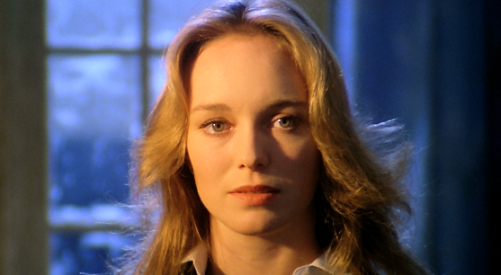
Liza Merril, the Lorelai Gilmore of gruesome Italian movies.
Joe, the plumber (Giovanni De Nava) arrives to look at the water situation, and Liza warns him it’s not good. The entire basement is flooded. While the two of them check out the damage, a dark-haired woman, Martha (Veronica Lazar) appears with a lantern to says she’s made a pathway for Joe to travel through the basement without getting waterlogged. The women leave and Joe gets to plumbing, post-haste. He finds a portion of the wall, leaking water, and begins to hammer through to the other side. Behind this wall is a whole other, hidden room (marked with that arcane “J” symbol, naturally). Liza, meanwhile, brings some towels to her room and finds another member of the hotel staff, Arthur (Gianpaolo Saccarola), lurking around. He’s looking for keys, as a number of the hotel rooms remain locked. Joe continues break apart the walls in the basement, and find something behind one wall. A decomposing hand shoots out from the crevice, then slowly and graphically gouges out his eyes.
Liza drives into town for some supplies and is forced to stop by a blind woman and her seeing-eye German shepherd standing in the centre of the highway. The woman, who identifies herself as Emily (Sarah Keller) – and her dog as “Dickie” – has the same milky eyes that spooked the house painter. Emily says that she’s been looking for Liza. Back at the hotel, Martha finds Joe huddled in the corner of the basement, his eyes gouged out and blood and orange goop flowing freely from his mouth. She also makes another startling discovery: a decomposed corpse – possibly the painter from 1927 – rises up from the dark muck.
Emily guides Liza to her house, set back from an intersection, and plays her a haunting li’l ditty on the piano. She instructs Liza to give up the hotel and go back whence she came, but Liza isn’t about to do that. The film then cuts to Dr. McCabe, sewing up Joe’s autopsied body in the hospital. (That was fast!) McCabe and his fellow doctor, walrus-moustached Harris (Al Cliver), have a special guest in attendance there in the autopsy theatre: that old corpse found in the hotel’s basement, allegedly dead for six (?) years. (Clearly, post-mortem dating methods have improved significantly.) Dr. Harris wants to hook the corpse up to his neato brainwave machine, so once McCabe leaves, he does just that. However, he gets called away on an emergency before he can notice the machine shows some brain activity emanating from the decades-old corpse.
Shortly thereafter, Joe’s widow, Mary-Ann (Laura De Marchi), and her Anne-of-Green-Gables-esque daughter, Jill (Maria Pia Marsala), arrive in the hospital. Mary-Ann doesn’t wait to be invited into the autopsy theatre, and just breezes right in (even though a poorly translated sign clearly reads “Do Not Entry”). Seeing her dead husband, she caresses his face, then completely dresses him in a full suit (?) and drapes rosary beads around his neck. But she looks over to the much older corpse and begins to scream. Around this same time, acid held in a jar begins to burble out of its container. When Jill runs into the theatre to hear why her mother is so distraught, she sees her mother, unconscious on the floor, acid spilling all over her face. Mary-Ann’s face melts away and spurts blood. Soon a huge puddle of blood and acidic foam begin to seep toward Jill. (Why was there so much acid in that jar?) She backs up, looking for a means of escape. She opens a door and finds more bagged bodies inside, including a man with a metal implement embedded in his face. Jill, probably a bit emotionally scarred by recent events, screams.
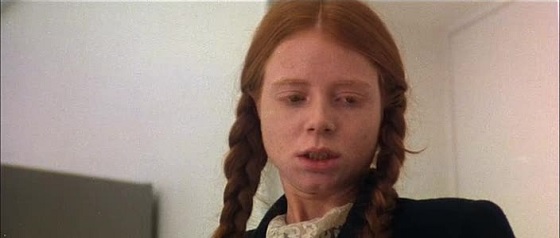
Jill, horrified to watch her mom drop acid … or, rather, have her face melted by acid.
After a chance meeting at a red light, Liza and Dr. McCabe enjoy a few adult beverages in a jazz bar (though Liza appears to be drinking a milkshake). Liza reveals that she’s done just about all the jobs there are to do when she was living in New York. Making a go of this hotel is kind of her last chance. McCabe wonders if she’s worried about all the accidents – y’know, including the one where a plumber had his eyes gouged out by an as-yet-uncaught assailant – and she’s concerned, no doubt. Totally worried. She’s also worried bout Martha and Arthur, hired help who sort of came with the hotel and are ultra-mysterioso. A funeral is held for Joe and Mary-Anne, and Jill stoically keeps her eyes to the ground the entire ceremony. At the end of the funeral, Jill is embraced by Emily, standing far off from the crowd. When Jill finally lifts her eyes to the camera, we can see that she is now blind like Emily.
Liza hears something in the hotel in the middle of the night. She travels downstairs with a lantern and finds Emily crouched in the kitchen. “Why didn’t you listen to me, Liza?” she wails. Now, she informs Liza, she will tell her everything. In Room 36, sixty years ago, there dwelled a painter named Schweick. Schweick found a key to the seven gateways of Hell (probably in the last place he looked for it). Mid-story, Emily pauses, sensing an unnatural presence. Liza, however, can see nothing. Emily asks Liza what’s immediately before her, and Liza tells her it’s a painting. Emily touches it and the buzzer for Room 36 rings instantly. Emily warns her: never enter Room 36. But Liza used to live in New York – in the late 1970s, to boot. If urban decay and stagflation didn’t scare her off, neither ail some ghosts. Where Emily touched the painting, her hands are now bleeding. She screams and runs from the hotel, her dog Dickie following.
The very next day, Liza uses an axe to open the locked Room 36. (It’s almost like she’s doing it just to spite Emily.) The furnishings inside have been covered with sheets and the curtains have been drawn. Liza lets in the light and discovers a book entitled “Eibon” on the desk. Then the closet door creaks open and a breeze seems to emanate from within. A bit spooked, she goes to the bathroom, and as soon as she opens the door, a lighting storm hits. On the bathroom wall, she sees a crucified corpse. Liza screams and runs downstairs, nearly knocking over the visiting Dr. McCabe. McCabe encourages her to return to Room 36, with him as backup. He kicks in the bathroom door and they can see two industrial strength nails in the wall, but no corpse anywhere in sight. ‘But I saw him!” Liza insists. “This looks more like rust than blood,” notes a skeptical Dr. McCabe. Liza tells the doctor about how Emily warned her about the room, and McCabe (as if he knows everyone in the town) asks who this Emily is. Liza describes her, but McCabe doesn’t believe her: “There’s no blind girl in a house by the crossroads.” More importantly, something has been taken from Room 36: the book of Eibon is missing.
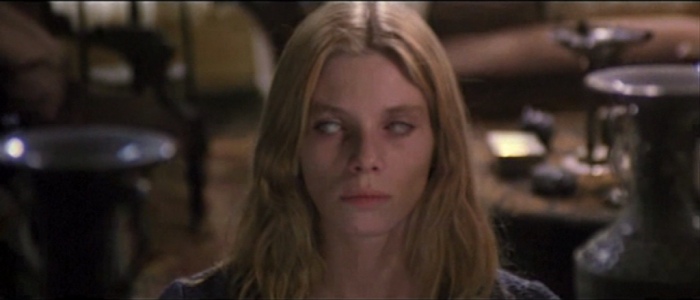
Wandering the streets, dissuading hotel owners from their life’s work.
Speaking of the book of Eibon, Liza sees it in the window of an antiquarian bookshop while out on a stroll with friend Martin Avery. But as soon as she enters the store, the book has completely changed to another title altogether. Martin and Liza part ways and Martin heads to the library to look at the original plans of the hotel. The librarian goes on his union-legislated break and leaves Martin Avery to climb the ladder to the upper shelf on his own, all the while grumbling about labour action. (The Beyond is staunchly anti-socialist.) Martin finds the plans for the 7 Doors Hotel, but as soon as he turns to the proper page, lightning strikes outside and he is thrown from the ladder to the marble floor below. Rendered unconscious, he doesn’t notice as a number of tarantulas crawl out of nowhere and begin to scale his body. Martin wakes just as the spiders crawl onto his face and begin to bite large chunks off his mouth and nose. Then one plucks out his eye and another pulls out his tongue. (I’m pretty sure real tarantulas don’t do any of those things, by the way.) Then, as if to add insult to injury, the page of architectural plans disappears!
Dr. McCabe, looking more and more like Indiana Jones with each wardrobe change, goes to investigate this house by the crossroads that Liza has been talking about. When he visits, the house is boarded up, seemingly abandoned. He uses hedgeclippers to break in, but the place seems like it’s been unused for years. However, covered in some cobwebs, McCabe finds the book of Eibon. At the hotel, Martha visits Room 36 to do some routine housekeeping. The bathtub, unfortunately, seems to be filled with a black sludge that even CLR might not be able to handle. She slides her hand under the water and digs out a massive hairball. The water starts to drain and who should emerge from the emptying tub but Joe, the Plumber! (Plumbers love tubs!) The undead and eyeless Joe grabs Martha by the head and forces her backward, shoving the wall’s embedded nail through the back of her head and out through her eye socket.
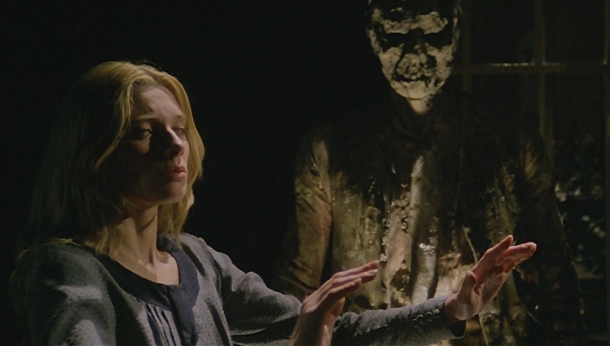
Looks like *somebody* was using an old photo on Tinder.
McCabe returns to that ancient corpse in the autopsy theatre and notices a strange symbol branded on the corpse’s wrist that he’s only seen in that book of Eibon before. Emily sits alone in the dark with Dickie, who seems unsettled by the storm outside. The piano begins to play on its own, startling her. “Who’s there?” she demands. Who is there? A greying corpse, clearly the body of Schweick. But as Emily gropes around in the dark, demanding answers from her unseen tormenters, more and more undead bodies begin to populate her drawing room: Joe, Mary-Ann, as well as Arthur (who we don’t even know is dead yet). “You can’t take me back!” she warns, then sics Dickie – who has heretofore been useless – on the dead people. Dickie attacks the dead painter, and he does it well, tearing at the corpse’s body. Suddenly all goes quiet. The corpses vanish and Dickie, covered in blood, heels beside his master. Then, out of nowhere, Dickie turns on Emily, tearing a huge, gaping wound in her throat, then biting her ear right off. It’s a bloodbath!
The phone rings in the darkened hotel, but nobody answers. Dr. McCabe is calling from a pay phone shrouded in fog. Liza doesn’t answer because she’s busy in the flooded basement, looking for Arthur. She finds his lantern, but no Arthur. Then, the creepy hotel help lunges out of the water and tries to drag Liza in with him. Liza kicks Arthur off her, then runs upstairs. She screams as she’s grabbed by Dr. McCabe (who must have been phoning from around the block). Liza tells him about Arthur, and McCabe, ever the skeptic, shouts, “I’m sick of all these stories!” He tells her that the blind woman’s house has been empty for at least fifty years. Also, that he found the book Liza secretly left for him and read it cover-to-cover. Nevertheless, he asks Liza to show him where Arthur is. She takes him to the basement, but Arthur is long gone. noting that the book of Eibon indicates the hotel hides one of seven gateways to Hell, he asks, “Who are you, Liza?”
Out of nowhere, a storm erupts in the basement. Both McCabe and Liza begin bleeding spontaneously. The basement begins to crumble around them, so they flee from the hotel. The painting, propped up against a wall, begins to bleed, as well. They drive away from the hotel and the rooms inside light up and shadowy figures move around within (as if someone inside were trying to scare away the Wet Bandits). Dr. McCabe drives them to the hospital, through seemingly empty streets. The hospital itself is also devoid of people. Well, living people. McCabe retrieves a gun from his office (guns are pretty typical office supplies), then attempts to call the FBI (?), but discovers the telephone is dead. That’s one thing it no longer has in common with the bodies in the morgue, which break through the window and try to drag Liza inside. McCabe shoots at one of the zombies until it releases Liza. They flee the office.
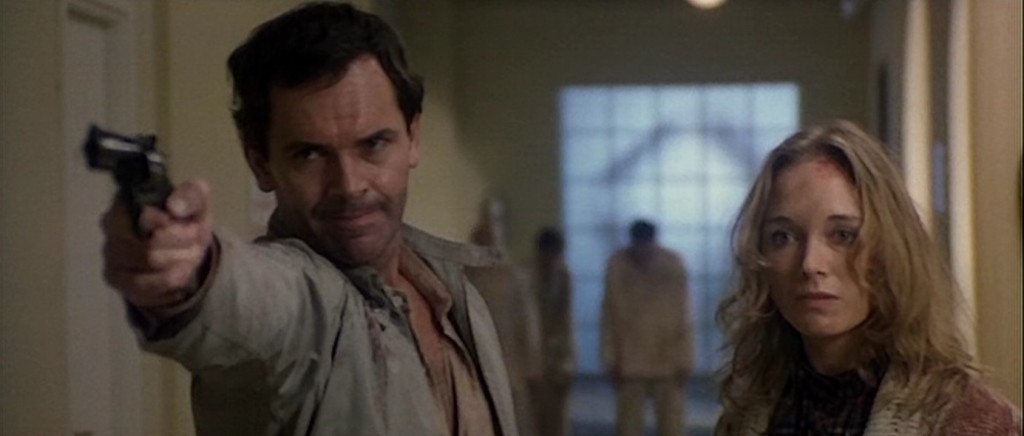
Dr. McCabe was top marksman at medical school.
McCabe pushes Liza into the elevator, but stays on the floor himself, shooting slowly shuffling corpse after slowly shuffling corpse. He runs out of bullets and locks himself in a storage room. Liza, meanwhile, enters the autopsy theatre, where she finds the blind Jill. (Liza apparently knows Jill by sight, as well. I guess she was closer to that plumber than we realized.) In the storage room, McCabe runs into his colleague Harris, who, having mistaken him for one of the undead, nearly kills him with a meat cleaver. The zombies begin to break into the storage room, so McCabe (having somehow found more bullets) opens fire, shooting a number of them in the head. The zombies shatter a glass door and the large shards fly into Harris’s face, killing him.
The lone surviving doctor makes it to the elevator, where he finds Liza and Jill. McCabe enters a cheat code, unlocking unlimited bullets, and fires them a clear path to the autopsy theatre. Inside, they’re ambushed by the corpses that claw their ways out of the clear body bags. Behind the door, a very old corpse – Schweick? – appears, seeming to direct the zombies. The little girl, Jill, turns on Liza, grabbing her face roughly, and McCabe doesn’t hesitate to blow half Jill’s face clean off. The doctor grabs Liza and they run downstairs, but find themselves in the basement of the hotel again. “Impossible!” shouts McCabe.
Slowly, the basement transforms into a weird hellscape (very similar to Schweick’s painting). The two of them wander around, seeking a way out, but the wasteland stretches on, seemingly forever. In time, the two of them go blind, just like Emily and Jill, and then disappear. And I guess the world ends shortly after that.

Backdrop for Springsteen hit, “Born To Run.”
Takeaway points:
- The best way to think about The Beyond is as one of those home renovation shows so popular on HGTV and TLC gone awry. The Beyond, if you think about it, is just a really gory and surreal episode of Love It or List It or The Property Brothers. Like, unless Gordon Ramsay helps out Liza Merril and the 7 Doors, he has no business calling his show Hotel Hell.
- Though there’s not a wealth to talk about – it’s difficult to present different readings of what is, for the most part, a surreal or imagistic film – we can discuss the high fetishization of violence in The Beyond. Obviously, most horror films – or at least those that we’d consider gory – indulge in a certain level of fetishization of violence. But Fulci turns the fetishization into a full-blown obsession. The goriest death scenes are lingered over, the camera leering at the murders like a peeping tom. The extreme length they’re given in a movie that clocks in under ninety minutes is almost unseemly. We watch as Schweick’s face is melted with hot oil for a very long time. Nearly as long as the time it takes a corpse to gouge out Joe’s eye, or acid to melt Mary-Ann’s face off. The over-emphasis becomes almost comical. Eye violence, in particular, gets a lot of play – whether it’s gouging or blinding (by spiders or, let’s say, magic). For Christmas’ sake, a woman gets a nail through the back of her head and it still somehow manages to poke out an eye.
- Speaking of which, what was the budget for dummy heads in this film? So many dummy heads were used and destroyed through various means, and in most cases, the heads don’t look too convincing. Mary-Ann’s acid attack, in particular, looks more like a department store mannequin being doused in Kool-Aid.
- Experts tell me that Fulci intended The Beyond as an homage to Surrealist playwright, Antonin Artaud. Artaud advocated for non-linear theatre, halfway between thought and pure image – a theatre he called “Theatre of Cruelty.” He also believed proper theatre should reflect his own nihilistic world view, something The Beyond certainly does – for, as far as I can tell, the world is literally sucked into Hell by the film’s conclusion.
- Most bizarre of all is how so much of The Beyond centres around the basement of his demonic hotel, when very, very few buildings in Louisiana have basements at all. The state has such a high water table, that building anything underground is nearly unheard of. (Even the cemeteries are almost all aboveground tombs!) They might as well have set The Beyond in the basement of The Alamo.
Truly terrifying or truly terrible?: There are some die-hard fans of Fulci’s work, and I won’t deny the movie is beautifully shot and features some extremely inventive gore, but it just seems like a wasted effort. Like a piñata sculpted by Michelangelo. Why do such a thing? The best horror, in my opinion, works because it embodies very real human fears and, in some way – whether very subtly or in an over-the-top fashion – explores why we have those fears. The Beyond is more like a supercut of all your greatest nightmares, devoid of context. Scary, with undeniably vivid images of horror, but to what end?
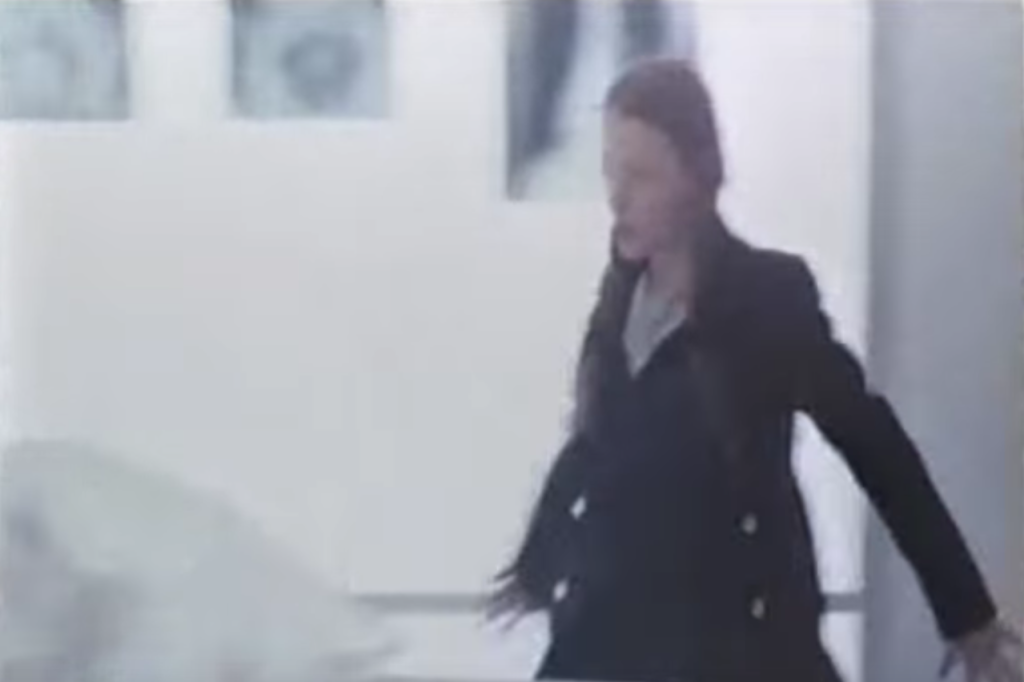
A blurry photo showing a pretty stellar outfit of the young, still-unpossessed Jill.
Best outfit: Jill’s school outfit, which makes her look a bit like a goth Madeleine, is pretty killer.
Best line: “I want to talk to Harris, and I’ll call the FBI.” – Dr. John McCabe, setting his priorities in order
Best kill: This is an impossible category. Think of “best kill” in a Fulci movie as a World Cup bracket that contains Brazil, Spain, and Argentina. The kills are the most elaborate and imaginative portions of The Beyond, and there are so many great ones to choose from. That said, I have to select Dr. McCabe shooting the top portion of young Jill’s face off as the winner. If only because it happens quickly, brutally, and without the lingering, extended treatment that so many of the other murders are given.
Unexpected cameo: Master of horror (and this film’s director) Lucio Fulci, plays the work-resistant librarian who inadvertently leaves Martin Avery to be killed by spiders.
Unexpected lesson(s) learned: In Louisiana (or Italy’s understanding of Louisiana), it is customary for the spouse of the deceased to not only identify the body in the morgue, but also dress the corpse for the funeral.
Most suitable band name derived from the movie: There are a number of good options: Room 36, Book of Eibon, and 7 Doors Hotel are all excellent choices.
